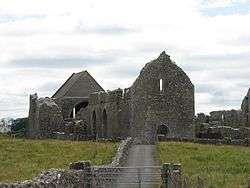Abbeyknockmoy
| Abbeyknockmoy Mainistir Chnoc Muaidhe | |
|---|---|
| Village | |
|
Ruins of the 12th century Cistercian Knockmoy Abbey | |
 Abbeyknockmoy Location in Ireland | |
| Coordinates: 53°26′13.2″N 08°44′49.2″W / 53.437000°N 8.747000°W | |
| Country | Ireland |
| Province | Connacht |
| County | County Galway |
Abbeyknockmoy (Irish: Mainistir Chnoc Muaidhe, meaning "Abbey of Muaidh's Hill") is a village and parish in County Galway, Republic of Ireland. It is best known for the nearby ruins of the 12th century Cistercian abbey, established with the Kings of Connacht as its benefactors. The abbey was the burial site of King Cathal Crobhdearg Ua Conchobair and contains fine examples of medieval wall paintings and sculpture. It was formerly part of the kingdom of the Soghain of Connacht.
Abbey
Abbeyknockmoy was originally a Cistercian abbey founded in 1190 by the King of Connacht, Cathal Crobhdearg Ua Conchobair,[1] in fulfilment of a vow made prior to a victory gained by Cathal against the English forces under Almeric de St. Lawrence.[2] Cathal died a Cistercian monk and was buried there in 1224.[3] The new abbey was occupied by Cistercian monks from Boyle Abbey.[2] Substantial parts of the abbey remain, showing close links with other abbeys in the west of Ireland.[1]
The abbey was decorated by medieval wall paintings, traces of which survive in the presbytery: they depict Saint Sebastian, the Crucifixion, the Trinity and the three living and three dead.[1] This momento-mori was intended to remind viewers of their own mortality, while St. Sebastian, whose martyrdom was depicted, was often invoked for protection from plague.[4] One of the surviving fragments also depicts a hunting scene, indicating that hunting was popular in medieval Ireland.[5] Additionally, the sculptors at Abbeyknockmoy can be identified as the same sculptors at work in Boyle Abbey, the so-called ‘School of the West’, a group of masons renowned for their fine stone carvings and idiosyncratic sculptural detailing.[6] There is a capital that includes a fine example of a sculptured head: according to Roger Stalley, "there is a fine royal head on one of the nave piers. The nose and chin are smashed, but the carefully defined eyes, elaborate crown and long curly hair are still intact".[3] He also suggests that the carved head actually represents Ua Conchobair, and "was perhaps a tribute to his benefactions".[7]
In the fourteenth century, the O’Kelly (Uí Cheallaigh) family, powerful lords of Uí Mhaine, replaced the O’Conors as the preeminent family in the region. They also became benefactors of the Cistercian foundation at Abbeyknockmoy. The O'Kellys were active patrons of the abbey, through the burial of family members there but also the continued succession of O'Kellys as abbots of Abbeyknockmoy.[8]

The monastery was plundered by William de Burgo in 1200.[9] In 1402, Malachy or Maolsheachlainn O’Kelly, lord of Uí Mhaine was buried in a tomb on the north wall of the presbytery, with his wife Finnuala O'Conor joining him a year later. Their tomb was erected in 1402 in a place normally kept for an important patron or founder's tomb.[10] In 1483, the abbot, John de Burgo (Burke) was accused of setting fire to the abbey.[11] The friary was granted to Valentine Blake in 1620 by King James I of England. The abbey stayed in the Blake family's possession for several centuries afterwards, with Francis Blake Forster of Ashfield recorded as the owner of the abbey in 1837.[12]
In the late 1980s, the OPW carried out work in the presbytery at Abbeyknockmoy to protect the wall paintings, which had been exposed to the elements until then.[13]
See also
Notes
- 1 2 3 Lalor, p 1
- 1 2 "County Galway, Ireland, Civil Parishes, Abbeyknockmoy: description from Lewis's Topographical Dictionary of Ireland, 1837". Retrieved 2008-04-04.
- 1 2 Doran, p 53
- ↑ "Abbeyknockmoy Cistercian Abbey | Monastic Ireland". www.monastic.ie. Retrieved 2016-10-27.
- ↑ Lydon, p 22
- ↑ "Abbeyknockmoy Cistercian Abbey | Monastic Ireland". www.monastic.ie. Retrieved 2016-10-27.
- ↑ Stalley, p 188; cited by Doran, p 53-54
- ↑ "Abbeyknockmoy Cistercian Abbey | Monastic Ireland". www.monastic.ie. Retrieved 2016-10-27.
- ↑ "Abbeyknockmoy". www.tuam-guide.com. Archived from the original on 8 May 2008. Retrieved 2008-04-06.
- ↑ "Abbeyknockmoy Cistercian Abbey | Monastic Ireland". www.monastic.ie. Retrieved 2016-10-27.
- ↑ "Abbeyknockmoy Cistercian Abbey | Monastic Ireland". www.monastic.ie. Retrieved 2016-10-27.
- ↑ "Abbeyknockmoy Cistercian Abbey | Monastic Ireland". www.monastic.ie. Retrieved 2016-10-27.
- ↑ "Abbeyknockmoy Cistercian Abbey | Monastic Ireland". www.monastic.ie. Retrieved 2016-10-27.
References
- Doran, Linda; Lyttleton, James, eds. (2008). Lordship in Medieval Ireland: Image and reality (Hardback, illustrated ed.). Dublin: Four Courts Press. ISBN 978-1-84682-041-0.
- Lalor, Brian, ed. (2003). The Encyclopedia of Ireland. Yale University Press. ISBN 978-0-300-09442-8.
- Lydon, James F. (1980). Ireland in the later Middle Ages (Second ed.). Dublin: Gill and Macmillan. ISBN 978-0-7171-0563-2.
- Stalley, Roger A. (1987). The Cistercian Monasteries of Ireland: An Account of the History, Art and Architecture of the White Monks in Ireland from 1142-1540. Yale University Press. ISBN 978-0-300-03737-1.
- Monastic Ireland, The Discovery Programme, accessed 27 October 2016, http://www.monastic.ie/history/abbeyknockmoy_cistercian_abbey/
